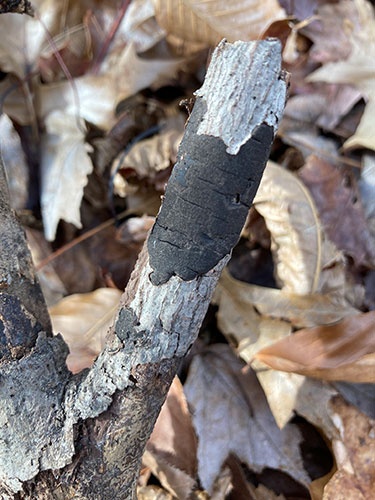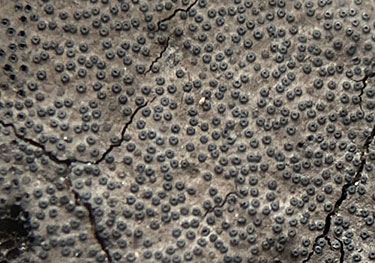Diatrype stigma
Scientific name: Diatrype stigma (Hoffm.) Fr.
Derivation of name: Stigma means "a spot" perhaps in
reference to the tiny "spotlike" bumps of the
perithecia on
the surface of the crust.
Synonyms: Sphaeria stigma Hoffm.
Common name(s): Common tarcrust (British name)
Phylum: Ascomycota
Order: Xylariales
Family: Diatrypaceae
Occurrence on wood substrate: Saprobic; forming
sheet-like growths (stromata) on decaying hardwood
branches, particularly beech; year-round.
Dimensions: The black crusts (stromata) of this fungus
vary from a few mm to more than 10 x 20 cm in size and
0.2-1.5 mm thick.
Description: The blackish-brown to black surface is
shiny, finely roughened to smooth, and sometimes
minutely cracked. The ostioles (i.e., openings) of the
perithecia project slightly from the stromatal surface,
forming tiny bumps marking the locations of perithecia
embedded just below the surface in a single layer. Flesh
whitish.
Comments: A number of other blackish,
crust-like
species can be mistaken for Diatrype stigma. In the
absence of microscopic examination, identifications
of black crust-like fungi should be considered tentative.
One look-alike to Diatrype stigma is Graphostroma
platystomum, pictured here in Figures 3
and 4. When
specimens are in good condition,
this species and
Diatrype stigma clearly differ macroscopically. With
age, though, the differences may
be less distinct.

Figure 1. An old specimen of Diatrype stigma.
This is a
common fungus on beech branches where
the fungus often
encircles the branch. The fungus gives the
impression that
the wood is burned. Cracks are common in older specimens.
Photo © Gary Emberger.

Figure 2. When magnified
with a hand lens, the tiny
bumplike pores of the embedded perithecia can be
seen all over the stromatal surface of the fungus.
Photo © Gary Emberger.

Figure 3.
The look-alike species Graphostroma
platystomum. This saprobic fungus
is reported to
occur on
a number of hardwoods including maple and oak. From a
distance, the species is blackish like Diatrype stigma and,
like D. stigma, may develop cracks with age. The species is
described as indefinitely effused, varying from 5x5 mm to
more than 20x20 cm in size and 0.3 to 1.5 mm thick.
Photo © Ethan Crenson.

Figure 4.
This magnified image of Graphostroma platystomum
reveals the presence of flat, black discs covering the stromatal
surface. These are the ostioles of perithecia embedded in the
underlying stroma. The
stromatal tissue between the discs is
brown/reddish-brown. Diatrype stigma, in contrast, lacks
discs and the stromatal tissue surrounding the
perithecia is
blackish.
Photo © Ethan Crenson.